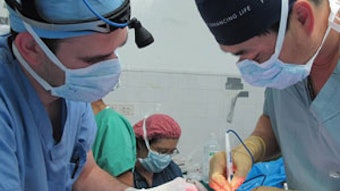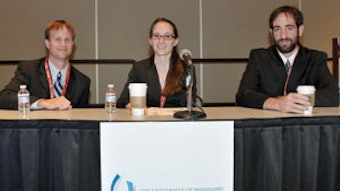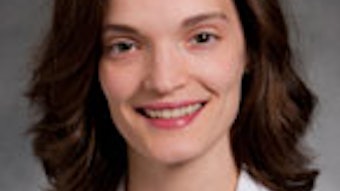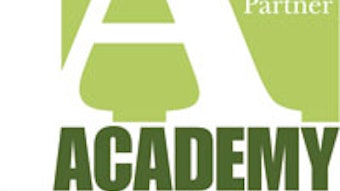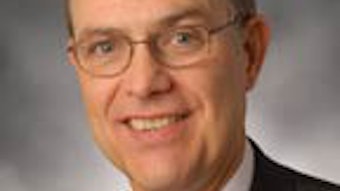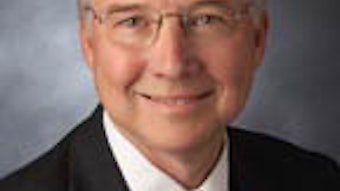Conferences in Geneva, Switzerland, on Salivary Gland Disease, Sialendoscopy
Eugene N. Myers, MD, FRCS, Edin (Hon) Pavel Dulguerov, MD, PhD, University of Geneva, did a remarkable job organizing the Third International Congress on Salivary Gland Diseases, March 22-23, which was attended by 152 delegates from 33 countries. The First International Congress took place in Geneva in 2002, and the extremely successful Second Congress in Pittsburgh in 2007. Five years later, there was enough new information for the organizing committee to gather the world’s outstanding specialists who deal with salivary gland function and disorders of the salivary apparatus. The make-up of both faculty and audience reflected the belief that the symbiotic contributions of clinicians, surgeons, pathologists, immunologists, radiologists, and researchers from different basic science fields make for a stimulating, highly productive way to study salivary gland problems. The meeting format allowed substantial open discussion after a formal presentation of important new information, as well as panel discussions, numerous free papers, and 22 poster presentations. Yoon-Woo Koh, MD, and his Korean colleagues presented significant new approaches including robot-assisted resection of the submandibular gland via the retroauricular approach. On the first day, Vincent L. M. Vander Poorten, MD, and Christopher H. Rassekh, MD, moderated a plenary session on pleomorphic adenomas, and featured lecturers, such as Dominique Chevalier, MD; Orlando Guntinas-Lichius, MD; Eugene N. Myers, MD; Chris H. J. Terhaard, MD; and Peter Zbaren, MD. Pilar Brito-Zeron, MD, Manuel Ramos-Casals, MD, and Athanasios G. Tzioufas, MD, contributed a plenary session on Sjögren syndrome. Drs. Myers and Chevalier moderated the third plenary session on refinements in parotid surgery, with Drs. Dulguerov and Guntinas-Lichius, Francis Marchal, MD, Miguel Quer i Agusti, MD, and Enrico Sesenna, MD. The second day included sessions on xerostomia, challenging cases of pleomorphic adenoma, and salivary gland cancer with Jorn Bullerdiek, MD, Fernando L. Dias, MD, Silvano DiPalma, MD, Roberto A. Lima, MD, PhD, and Drs. Rassekh, Terhaard, and Vander Porten. Claudio Cernea, MD, gave a special lecture on parotidectomy for skin malignancy. A thoroughly enjoyable gala dinner with an exceptional menu took place at the Hotel Beau Rivage, one of Geneva’s finest hotels, and was a highlight of the Congress. First International Sialendoscopy Conference The First International Sialendoscopy Conference took place March 24-25, with Dr. Marchal as the conference director and Dr. Myers as the honorary president. For the first time, this conference brought together 106 leading specialists with expertise in sialendoscopy from 48 countries. This followed the unparalleled success of sialendoscopy courses since 2002, in which more than 600 physicians from 54 countries were trained in this new field. During the ensuing years, the technique has attracted significant interest and popularity worldwide. Building on Dr. Marchal’s pioneering work in Geneva, sialendoscopy has been continuously developed and improved. Using techniques of minimally invasive surgery, which allow for optical exploration of the salivary duct system, it dramatically changed the management of patients with chronic sialadenitis and salivary calculi, saving many patients from removal of their salivary glands. After Dr. Marchal’s opening address, there followed brief introductory comments about sialendoscopy from many international thought leaders. Dr. Myers gave an interesting and provocative lecture entitled “Sialendoscopy: A Paradigm Shift?” showing remarkable improvements in management of salivary gland inflammatory conditions using sialendoscopy. Six sessions included a variety of outstanding speakers discussing assessment, sialadenitis, non-sialendoscopy treatments, conservative techniques, issues at the beginning, stones, strictures, and the future. A gala dinner at the Restaurant du Parc des Eaux Vives, Geneva, climaxed the outstanding social events. Overall, this meeting was highly successful, introducing beginners to fundamentals of sialendoscopy and experts to new concepts.
Eugene N. Myers, MD, FRCS, Edin (Hon)
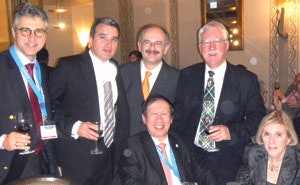 (Back left to right) Drs. Levent Soylu, Francis Marchal, Claudio Cernea, Randall Morton. (Front left to right) Dr. Kwang H. Kim and Mrs. Barbara L. Myers.
(Back left to right) Drs. Levent Soylu, Francis Marchal, Claudio Cernea, Randall Morton. (Front left to right) Dr. Kwang H. Kim and Mrs. Barbara L. Myers.Pavel Dulguerov, MD, PhD, University of Geneva, did a remarkable job organizing the Third International Congress on Salivary Gland Diseases, March 22-23, which was attended by 152 delegates from 33 countries.
The First International Congress took place in Geneva in 2002, and the extremely successful Second Congress in Pittsburgh in 2007. Five years later, there was enough new information for the organizing committee to gather the world’s outstanding specialists who deal with salivary gland function and disorders of the salivary apparatus.
The make-up of both faculty and audience reflected the belief that the symbiotic contributions of clinicians, surgeons, pathologists, immunologists, radiologists, and researchers from different basic science fields make for a stimulating, highly productive way to study salivary gland problems.
The meeting format allowed substantial open discussion after a formal presentation of important new information, as well as panel discussions, numerous free papers, and 22 poster presentations. Yoon-Woo Koh, MD, and his Korean colleagues presented significant new approaches including robot-assisted resection of the submandibular gland via the retroauricular approach.
On the first day, Vincent L. M. Vander Poorten, MD, and Christopher H. Rassekh, MD, moderated a plenary session on pleomorphic adenomas, and featured lecturers, such as Dominique Chevalier, MD; Orlando Guntinas-Lichius, MD; Eugene N. Myers, MD; Chris H. J. Terhaard, MD; and Peter Zbaren, MD.
Pilar Brito-Zeron, MD, Manuel Ramos-Casals, MD, and Athanasios G. Tzioufas, MD, contributed a plenary session on Sjögren syndrome. Drs. Myers and Chevalier moderated the third plenary session on refinements in parotid surgery, with Drs. Dulguerov and Guntinas-Lichius, Francis Marchal, MD, Miguel Quer i Agusti, MD, and Enrico Sesenna, MD.
The second day included sessions on xerostomia, challenging cases of pleomorphic adenoma, and salivary gland cancer with Jorn Bullerdiek, MD, Fernando L. Dias, MD, Silvano DiPalma, MD, Roberto A. Lima, MD, PhD, and Drs. Rassekh, Terhaard, and Vander Porten. Claudio Cernea, MD, gave a special lecture on parotidectomy for skin malignancy.
A thoroughly enjoyable gala dinner with an exceptional menu took place at the Hotel Beau Rivage, one of Geneva’s finest hotels, and was a highlight of the Congress.
First International Sialendoscopy Conference
The First International Sialendoscopy Conference took place March 24-25, with Dr. Marchal as the conference director and Dr. Myers as the honorary president.
For the first time, this conference brought together 106 leading specialists with expertise in sialendoscopy from 48 countries. This followed the unparalleled success of sialendoscopy courses since 2002, in which more than 600 physicians from 54 countries were trained in this new field.
During the ensuing years, the technique has attracted significant interest and popularity worldwide. Building on Dr. Marchal’s pioneering work in Geneva, sialendoscopy has been continuously developed and improved. Using techniques of minimally invasive surgery, which allow for optical exploration of the salivary duct system, it dramatically changed the management of patients with chronic sialadenitis and salivary calculi, saving many patients from removal of their salivary glands.
After Dr. Marchal’s opening address, there followed brief introductory comments about sialendoscopy from many international thought leaders. Dr. Myers gave an interesting and provocative lecture entitled “Sialendoscopy: A Paradigm Shift?” showing remarkable improvements in management of salivary gland inflammatory conditions using sialendoscopy.
Six sessions included a variety of outstanding speakers discussing assessment, sialadenitis, non-sialendoscopy treatments, conservative techniques, issues at the beginning, stones, strictures, and the future.
A gala dinner at the Restaurant du Parc des Eaux Vives, Geneva, climaxed the outstanding social events. Overall, this meeting was highly successful, introducing beginners to fundamentals of sialendoscopy and experts to new concepts.
